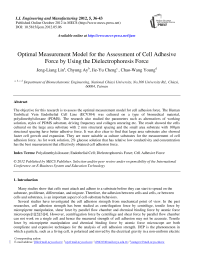Optimal Measurement Model for the Assessment of Cell Adhesive Force by Using the Dielectrophoresis Force
Автор: Jeng-Liang Lin, Chyung Ay, Jie-Yu Cheng, Chao-Wang Young
Журнал: International Journal of Engineering and Manufacturing(IJEM) @ijem
Статья в выпуске: 5 vol.2, 2012 года.
Бесплатный доступ
The objective for this research is to assess the optimal measurement model for cell adhesion force. The Human Umbilical Vein Endothelial Cell Line (ECV304) was cultured on a type of biomedical material, polydimethylsiloxane (PDMS). The research also studied the parameters such as alternatives of working solution, styles of PDMS substrate, driving frequency and collagen smearing etc. The result showed the cells cultured on the large area substrate with 2 mm structural spacing and the small area substrate with 100μm structural spacing have better adhesive force. It was also clear to find that large area substrates also showed faster cell growth and expansion. They are more suitable as culture substrates for the measurement of cell adhesion force. As for work solution, 2% glucose solution that has relative low conductivity and concentration has the best measurement that effectively obtained cell adhesion force.
Polydimethylsiloxane, Endothelial Cell, Dielectrophoresis Force, Cell Adhesive Force
Короткий адрес: https://sciup.org/15014336
IDR: 15014336
Список литературы Optimal Measurement Model for the Assessment of Cell Adhesive Force by Using the Dielectrophoresis Force
- O. Thoumine, A. Ott, D. Louvard, “Critical centrifugal forces induce adhesion rupture or structural reorganization in cultured cells.” Cell Motil Cytoskeleton. Vol. 33, pp. 276-287, 1996.
- O. Thoumine, A. Ott, “Comparison of the mechanical properties of normal and transformed fibroblasts.” Biorheology. Vol.34, pp.309-326, 1997.
- G. A. Truskey, T. L.Proulx, “Relationship between 3T3 cell spreading and the strength of adhesion on glass and silane surfaces.” Biomaterials. Vol.14, pp.243-254, 1993.
- Z. Leonenko, E. Finot, M. Amrein, “Adhesive interaction measured between AFM probe and lung epithelial type II cells.” Ultramicroscopy, vol. 107, pp. 948-953, 2007.
- T. B. Jones, Electromechanics of particles. Cambridge, Cambridge University Press; 1995.
- R. Pethig, “Dielectrophoresis: using inhomogeneous AC electric fields separate and manipulate cells.” Crit. Rev. Biotechnology, vol.16, pp.331-348, 1996.
- H .Dalir, Y. Yanagida, T. Hatsuzawa, “Probing DNA mechanical characteristics by dielectrophoresis”, Sensors and Actuators B. vol.136, pp.472-478, 2009.
- H. Morgan, M. P. Hughes, N. G. Green, “Separation of Submicron Bioparticles by Dielectrophoresis”, Biophysical Journal.vol. 77, pp. 516-525, 1999.
- L. Benguigui, I. J. Lin, “More about the dielectrophoretic force”, J. Appl Phys. Vol. 53, pp.1141-1143, 1982.


